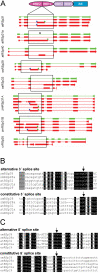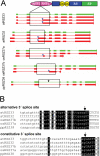Evolutionary conservation and regulation of particular alternative splicing events in plant SR proteins
- PMID: 16936312
- PMCID: PMC1636356
- DOI: 10.1093/nar/gkl570
Evolutionary conservation and regulation of particular alternative splicing events in plant SR proteins
Abstract
Alternative splicing is an important mechanism for fine tuning of gene expression at the post-transcriptional level. SR proteins govern splice site selection and spliceosome assembly. The Arabidopsis genome encodes 19 SR proteins, several of which have no orthologues in metazoan. Three of the plant specific subfamilies are characterized by the presence of a relatively long alternatively spliced intron located in their first RNA recognition motif, which potentially results in an extremely truncated protein. In atRSZ33, a member of the RS2Z subfamily, this alternative splicing event was shown to be autoregulated. Here we show that atRSp31, a member of the RS subfamily, does not autoregulate alternative splicing of its similarly positioned intron. Interestingly, this alternative splicing event is regulated by atRSZ33. We demonstrate that the positions of these long introns and their capability for alternative splicing are conserved from green algae to flowering plants. Moreover, in particular alternative splicing events the splicing signals are embedded into highly conserved sequences. In different taxa, these conserved sequences occur in at least one gene within a subfamily. The evolutionary preservation of alternative splice forms together with highly conserved intron features argues for additional functions hidden in the genes of these plant-specific SR proteins.
Figures






Similar articles
-
Survey of conserved alternative splicing events of mRNAs encoding SR proteins in land plants.Mol Biol Evol. 2006 May;23(5):1085-94. doi: 10.1093/molbev/msj118. Epub 2006 Mar 6. Mol Biol Evol. 2006. PMID: 16520337
-
Two novel arginine/serine (SR) proteins in maize are differentially spliced and utilize non-canonical splice sites.Biochim Biophys Acta. 2005 May 1;1728(3):105-14. doi: 10.1016/j.bbaexp.2005.01.004. Epub 2005 Feb 23. Biochim Biophys Acta. 2005. PMID: 15780972
-
Characterization of a novel arginine/serine-rich splicing factor in Arabidopsis.Plant Cell. 1996 Dec;8(12):2255-64. doi: 10.1105/tpc.8.12.2255. Plant Cell. 1996. PMID: 8989882 Free PMC article.
-
Plant serine/arginine-rich proteins: roles in precursor messenger RNA splicing, plant development, and stress responses.Wiley Interdiscip Rev RNA. 2011 Nov-Dec;2(6):875-89. doi: 10.1002/wrna.98. Epub 2011 Jul 15. Wiley Interdiscip Rev RNA. 2011. PMID: 21766458 Review.
-
Alternative splicing of pre-messenger RNAs in plants in the genomic era.Annu Rev Plant Biol. 2007;58:267-94. doi: 10.1146/annurev.arplant.58.032806.103754. Annu Rev Plant Biol. 2007. PMID: 17222076 Review.
Cited by
-
Crossregulation and functional redundancy between the splicing regulator PTB and its paralogs nPTB and ROD1.Mol Cell. 2007 Aug 3;27(3):420-34. doi: 10.1016/j.molcel.2007.06.016. Mol Cell. 2007. PMID: 17679092 Free PMC article.
-
Implementing a rational and consistent nomenclature for serine/arginine-rich protein splicing factors (SR proteins) in plants.Plant Cell. 2010 Sep;22(9):2926-9. doi: 10.1105/tpc.110.078352. Epub 2010 Sep 30. Plant Cell. 2010. PMID: 20884799 Free PMC article.
-
Alternative splicing and translation play important roles in hypoxic germination in rice.J Exp Bot. 2019 Feb 5;70(3):817-833. doi: 10.1093/jxb/ery393. J Exp Bot. 2019. PMID: 30535157 Free PMC article.
-
Alternative splicing of anciently exonized 5S rRNA regulates plant transcription factor TFIIIA.Genome Res. 2009 May;19(5):913-21. doi: 10.1101/gr.086876.108. Epub 2009 Feb 10. Genome Res. 2009. PMID: 19211543 Free PMC article.
-
The multiple lives of NMD factors: balancing roles in gene and genome regulation.Nat Rev Genet. 2008 Sep;9(9):699-712. doi: 10.1038/nrg2402. Nat Rev Genet. 2008. PMID: 18679436 Free PMC article. Review.
References
Publication types
MeSH terms
Substances
LinkOut - more resources
Full Text Sources
Other Literature Sources
Molecular Biology Databases
Research Materials

